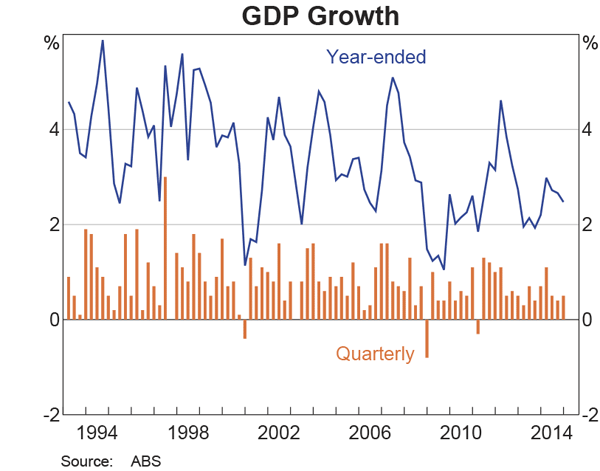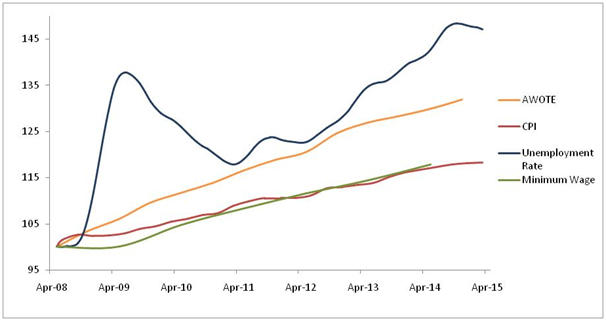The Fair Work Commission will soon present the results of its 2014–2015 minimum wage review. The decision will detail the rates to be set in the national minimum wage order for the 2016 financial year.
The national minimum wage for a full-time employee is currently $640.90 per week, or $16.87 per hour.
Wage Recommendations
In reaching a decision the Expert Panel is required to consider submissions from interested parties.
- The Unions propose a $27.00 wage increase per week.
- The Australian Industry Group (Ai Group) submits that this is “unrealistic and unsustainable” and instead submits that the increase should be 1.6% ($10.25 a week).
- The Australian Government, the Australian Chamber of Commerce and Industry (ACCI), and the Australian Business Industrial (ABI) urge the Panel to adopt a cautious approach.
- The ABI proposes a “modest sustainable increase” while the ACCI recommends “an increase of no more than $5.70 per week”.
Economic Conditions
Unsurprisingly, a significant point of contention is the viability of an increase in the minimum wage given perceptions of the current economic climate. GDP growth is currently below trend, as can be seen in this graph from the Reserve Bank of Australia’s latest chart pack.

Unemployment has recently trended up and wages growth has slowed to a more moderate pace than evidenced in prior years, as can be seen in the graph below, which depicts the period from the global financial crisis to now.

Trend series data was not available for the entire time period for AWOTE, minimum wage or CPI, so original series data has been used. Trend series data has been utilised for the unemployment rate. Data has been sourced from the Australian Bureau of Statistics and the Fair Work Commission.
The Federal Government submits that “subdued wages growth and low consumer price inflation indicate that businesses find it difficult to afford wage increases at the present time”. In this context it suggests that wage flexibility will be an important mechanism to support employment.
In contrast, the Federal Opposition submits that a “fair and economically responsible” increase is appropriate. The Australian Council of Trade Unions (ACTU) further highlights the importance of a fair safety net, which will lower inequality and thus have a positive effect on health, social cohesion and economic growth. In framing its submission, the ACTU emphasises the strength of the Australian economy relative to other nations, noting that the economy grew by 2.5% in 2014, which was faster than many OECD countries.
Blackrock’s Head of Fixed Income in Australia, Steve Miller, has been reported as saying that Australia’s unemployment rate risks hitting 7% by the end of 2015 and could move higher in 2016 as the economy continues to struggle with the sharp drop in mining investment.
Another commentator, Capital Economics, predicted the unemployment rate will reach 7% by the end of 2015. Goldman Sachs anticipated it will reach 6.5% by the end of the year. The rate is unlikely to increase evenly across Australia, with Western Australia tipped to be the worst hit, and NSW likely to experience the lowest rise.
Industry Comparison
On an industry basis, there has been variation in wage growth and growth in employment opportunities, as can be seen in the graphs below. Only original series data was available on an industry basis.
Ordinary Time Earnings (AWOTE) by Industry for Selected Industries


Productivity
There has also been some debate about whether or not current gains in productivity are sufficient to support a wage increase.
Although Total Factor Productivity performance has often been negative, Labour Productivity has achieved positive growth for a lengthy period of time, as can be seen in the graph below from the Reserve Bank of Australia.

In making the case for a “decent minimum wage” the Federal Opposition states that the growth in the minimum wage has not kept pace with increases in labour productivity. It also references OECD data that shows Australia’s “minimum wage bite” (the minimum wage relative to the Average wage) fell by the most of any OECD country over the 2003 to 2013 period.
The Federal Government submits that while Labour Productivity has increased in recent years, it is important to take into account the economic and labour market environment. It states that capital investment will start to reverse as resources investment declines in conjunction with productivity growth, and that productivity growth outside the resources sector has slowed over the past decade.
Youth Employment
A further issue relates to the impact of an increase in the minimum wage on youth employment prospects. The Federal Government proposes that it is particularly difficult for young people to find work when the labour market is subdued, and that an increase in the minimum wage would only exacerbate this problem. However, the Australian Council of Social Service (ACOSS) states that there is no convincing evidence to indicate that the present minimum wage levels for young people have reduced their employment prospects relative to workers in other age groups.
Minimum Wage Adjustments and Unemployment
In general, the relationship between the minimum wage and employment level is a significant element of the annual wage review decision. To date the panel has concluded that modest minimum wage adjustments (defined by reference to current economic circumstances) have insignificant or zero effects on employment.
While the ACTU submits that evidence supporting this proposition is accurate, there has been a push from industry for the Panel to reconsider its position.
Most notably, the ABI and ACCI cite recent international research which suggests that a number of prominent studies previously brought to the Panel’s attention may be methodologically flawed.
Although the debate is still ongoing, the ABI proposes that the Panel adopt a more tentative conclusion until the outcome is better known.
The ACCI also points out recent studies that suggest even “modest” wage increases may have some negative effects, and that any effects found overseas are likely to be amplified in Australia, taking into consideration Australia’s higher minimum wage.